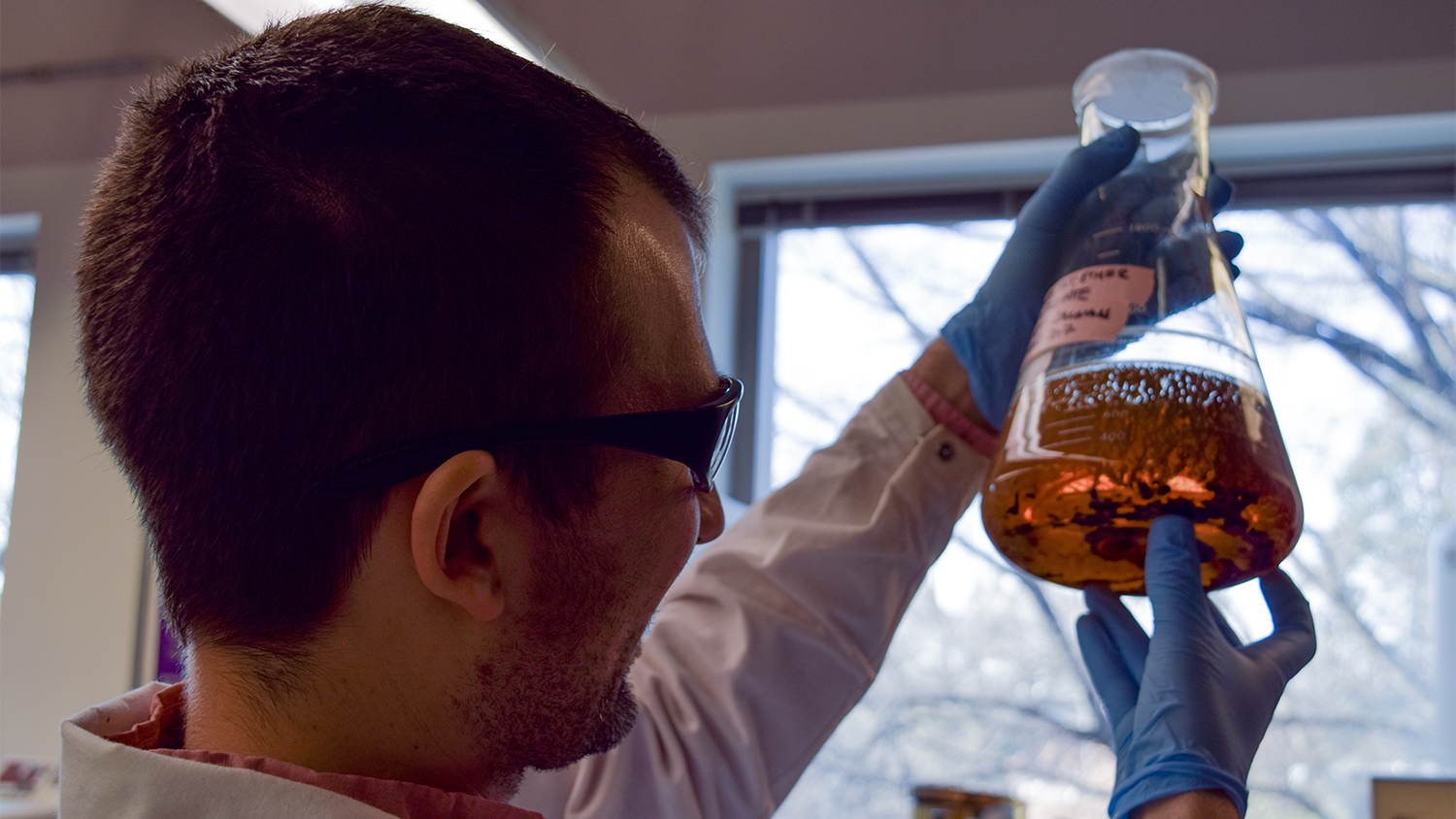Exploring sustainable air travel with jet fuel from trees

Researchers in NC State’s Department of Forest Biomaterials are working to make jet fuel from a renewable resource: trees. If successful, air travel could become cleaner and more environmentally-friendly, with alternative jet fuels proving to reduce lifetime greenhouse gas emissions and burn 40% cleaner.
In the lab, Matthew Kollman, a Forest Biomaterials doctoral student and primary author of the research study, has been working with lignin — a molecule deposited in many plants’ cell walls, most commonly wood plants such as trees — to try to break it down into jet fuel. Other researchers around the world have successfully used vegetable oils to commercialize into jet fuel. Lignin is a more desirable renewable resource for jet fuel since it has a higher carbon to oxygen ratio than other natural polymers such as cellulose and starch.
“It takes advantage of trees being a renewable resource,” said Kollman. “Trees take in carbon dioxide from the atmosphere, and when we burn the fuel from the trees, it omits carbon dioxide back into the atmosphere, but then the trees take it back. It reduces the carbon footprint of flying, and the planes’ emissions will be cleaner.”
It has been a complex process trying to break the lignin down into simpler molecules that can then upgrade into jet fuel. One problem is that lignin, when broken down into simpler molecules, reassembles back to a char-like material instead of upgraded to jet fuel. While others have done a lot of work on simple model compounds that mimic lignin, working with the real thing introduces new variables, such as a more complex and varied molecular structure and contaminants that can harm catalysts. What works for the model compounds, does not appear to translate directly to actual lignin.
Going forward, Kollman hopes that developing a two-stage catalytic process will overcome the challenges of using lignin to make jet fuel. The process conditions of each stage can be optimized and the best catalyst selected for each step. In the first step, Kollman is working to deconstruct the lignin into fragments with jet-fuel range carbon numbers and upgrade the resulting bio-oil through two processes: hydrogenation, reducing or saturating organic compounds, and hydrodeoxygenation, removing oxygen from oxygen-containing compounds. The final liquid product will be characterized, per American Society for Testing and Materials standards, for aromatic content, energy content, oxygen content, and volatility to verify its suitability as sustainable jet fuel.
Improving impacts on the environment
Over the past 10 years, the fuel efficiency of air travel has improved by 10%. However, as a result of the increased number and frequency of flights, carbon dioxide emissions have increased by 32%. Technological advances are being made, but there is still room for improvement. Air travel accounts for 2% of global human-made carbon dioxide emissions. Carbon dioxide — a primary greenhouse gas — poses several risks to the environment and people’s health, from causing climate change by trapping heat to contributing to respiratory disease from the smog and air pollution it emits.
“Our goal is to try and reduce our impact on the environment,” Kollman explained. “Researchers stress that we need to have a reduction in the number of planes in the air as well. No matter what we do to make planes more efficient, the number of flights continues to increase and technological advancements cannot keep up. I think people need to realize that we can’t keep consuming more and more; it’s not sustainable.”
In addition to reducing the carbon footprint of air travel, Kollman and his fellow researchers aspire to grow the forest products sector of the bioeconomy, which comprises parts of the economy that use renewable biological resources from both the land and the sea to produce food, materials and energy.
Exploring how jet fuel can be used from trees is one of three research projects Kollman is currently working on, and one that he hopes to finish next spring before he graduates. Post-graduation, Kollman plans to work with a company or lab that also values sustainability to further his work designing products made from renewable sources.
In the last year, Kollman has become more interested in public policy, which may translate into a future career as a science adviser. While using trees to create jet fuel is exponentially better than using a non-renewable resource, many activists and concerned citizens are concerned about cutting down trees.
“A lot of people are concerned about deforestation, and rightfully so,” Kollman said. “Over the past 100 years, we have had a growth in forests, not a decline. Large tracts of land have been deforested unsustainably in the rainforest, Indonesia and Southeast Asia. There is a way we can harvest resources sustainably to still provide for society’s needs, and that’s done pretty well in the U.S.”
- Categories: